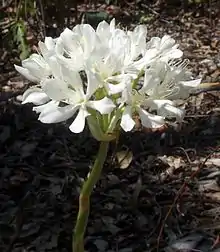| Proiphys | |
|---|---|
 | |
| Proiphys amboinensis | |
| Scientific classification | |
| Kingdom: | Plantae |
| Clade: | Tracheophytes |
| Clade: | Angiosperms |
| Clade: | Monocots |
| Order: | Asparagales |
| Family: | Amaryllidaceae |
| Subfamily: | Amaryllidoideae |
| Genus: | Proiphys Herb.[1][2] |
| Synonyms[3] | |
| |
Proiphys is a genus of herbaceous, perennial and bulbous plants in the family Amaryllidaceae, subfamily Amaryllidoideae.[4] It includes 5 accepted species[5] that are native to Southeast Asia, Papuasia, and Australia.[6]
- Proiphys alba (R.Br.)Mabb.[8] - New Guinea, Qld, NT, WA
- Proiphys amboinensis (L.) Herb.[1] - Thailand, Philippines, Sulawesi, Lesser Sunda Islands, Papuasia, Qld, WA; known as "Cardwell Lily"[9]
- Proiphys cunninghamii (Aiton ex Lindl.) Mabb.[8] - Qld, NSW; known as "Brisbane Lily" or "Moreton Bay Lily"[9]
- Proiphys infundibularis D.L.Jones & Dowe[10] - Qld
- Proiphys kimberleyensis M.D.Barrett & R.L.Barrett[11] - Northwestern Australia
Uses
Their flowers and leaves make them desirable garden subjects, but they are not widely cultivated as ornamental plants.[6]
References
- 1 2 Appendix: 42 (1821).
- ↑ "Proiphys". Australian Plant Name Index (APNI), IBIS database. Centre for Plant Biodiversity Research, Australian Government, Canberra. Retrieved 2008-11-01.
- 1 2 Royal Botanical Gardens, Kew. World Checklist of Monocotyledons: Proiphys . Accessed May 26, 2009.
- ↑ Stevens, P.F., Angiosperm Phylogeny Website: Asparagales: Amaryllidoideae
- ↑ "Proiphys Herb. : Plants of the World Online". Royal Botanic Garden Kew Science. Retrieved August 10, 2019.
- 1 2 Effie Mullins, 1989. The genus Proiphys. Australian National Botanical Gardens. Accessed May 26, 2009.
- ↑ Atlas of Living Australia, genus Proiphys
- 1 2 Taxon 29: 601 (1980).
- 1 2 "Adriana". Australian Plant Name Index (APNI), IBIS database. Centre for Plant Biodiversity Research, Australian Government, Canberra. Retrieved 2008-11-01.
- ↑ Austrobaileya 6: 121 (2001).
- ↑ "Proiphys kimberleyensis M.D.Barrett & R.L.Barrett | Plants of the Word Online | Kew Science". Kew Science. Retrieved August 10, 2019.
This article is issued from Wikipedia. The text is licensed under Creative Commons - Attribution - Sharealike. Additional terms may apply for the media files.